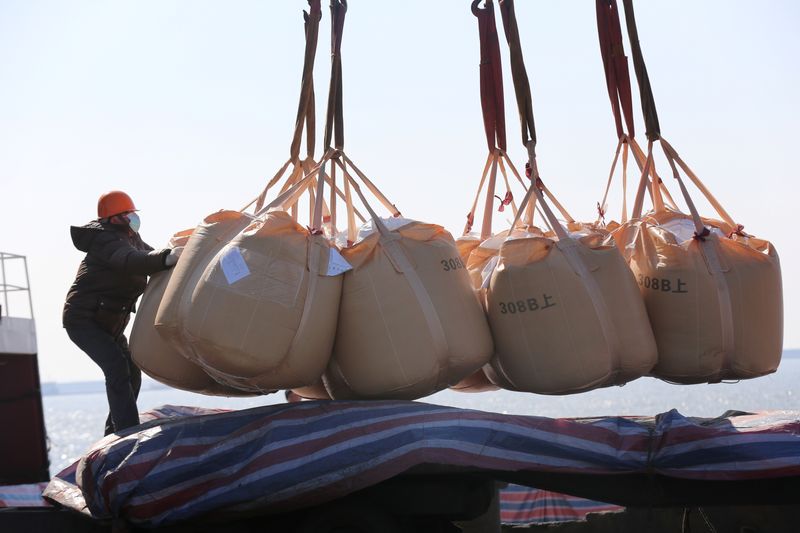Asian fertiliser buyers turn away from key exporter China amid growing curbs
2023.12.18 03:12

© Reuters. A worker wearing a face mask transports fertilisers for export at a port in Nantong, Jiangsu province, China January 31, 2020. China Daily via REUTERS/file photo
By Mei Mei Chu and Rajendra Jadhav
BEIJING/MUMBAI (Reuters) – Asian fertiliser buyers are seeking alternatives to Chinese supplies on concerns the world’s top exporter has become an increasingly unreliable supplier after curbs on shipments to protect its domestic market, buyers and analysts said.
China is the world’s biggest exporter of phosphate and a major supplier of urea, but since 2021 it has imposed measures including export quotas and lengthy inspection requirements on the fertiliser ingredients to cool domestic prices.
Urea exports plunged 24% to 2.8 million metric tons in 2022 from the year before and though higher this year, remain below the previous years’ average level.
Phosphate exports were brisk earlier in the year but have also been throttled back in recent months, leading to a squeeze in global supply that has pushed up prices.
The Chinese government’s growing intervention in the exports means the country will be an even less reliable supplier in 2024, said Josh Linville, director of fertiliser at brokerage StoneX Group Inc.
“Normally, market factors call the shots on what happens. Now, we have to try and figure out what the central government is thinking and its reaction can swing heavily from side to side. Buyers will have to diversify,” he said.
U.S prices for di-ammonium phosphate (DAP), a global benchmark for the industry, have risen 26% since mid-July to $617.30 per ton, according to LSEG data.
“The limitations imposed by China are pushing up urea and di-ammonium phosphate prices, but we don’t anticipate significant increases,” said a senior official with a New Delhi-based fertiliser company.
India is one of the world’s top fertiliser buyers. Chinese urea exports to the country in the first half of the 2023/24 year starting in April plunged 58% from a year ago to 335,963 tons, according to data compiled by India’s trade ministry.
However, readily available product from alternative suppliers including Russia, Oman, and the United Arab Emirates are offsetting the lower shipments from China, added the official.
MARKET IN LIMBO
Malaysian buyers are also switching away from China, buying up phosphate from Vietnam and Egypt, said Teo Tee Seng, managing director of fertilizer and agrochemicals supplier Behn Meyer Agricare in Kuala Lumpur.
“The global market has been in limbo due to China’s export restrictions,” he said.
China’s DAP and mono-ammonium phosphate (MAP) sales have slowed in recent months amid declining domestic production, said traders and analysts.
In October exports of DAP dropped by 12.5% from a year earlier while MAP exports were down 10%, Chinese customs data shows.
“Our normal supplier has reduced their packing size to 8 kilogrammes now, it used to be 25 kilogrammes,” said Malaysian importer Ng Wei Houng.
South Korea, which has complained to China over delays in urea exports, is also looking for alternatives. It uses urea both as a fertiliser and as a diesel fuel additive.
“We are diversifying to receive imports from countries like Vietnam, Indonesia and Saudi Arabia and will continue this trend going forward,” said an official from a major South Korean urea distributor, who declined to be identified as he was not authorised to speak to media.
Seoul expanded its urea reserve to protect against the rising volatility, securing additional supplies from Vietnam, the government said this month.
Urea exports from China next year are expected to increase incrementally from 2023 to around 4 million tons, analysts said, but shipments will remain tight into the first half of the year.
China has asked 15 major fertiliser trading firms to limit their total exports in 2024 to 944,000 metric tons, and is expected to issue quotas to other manufacturers, said Gavin Ju, principal fertiliser analyst at CRU Group.
China’s National Development and Reform Commission did not respond to a request for comment on its quota allocations.








